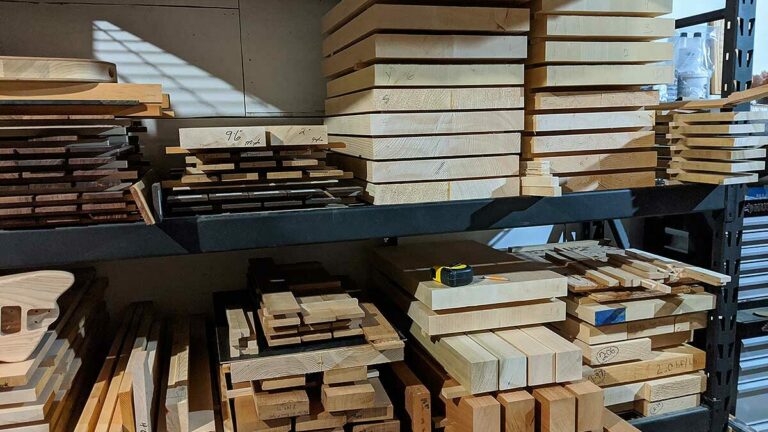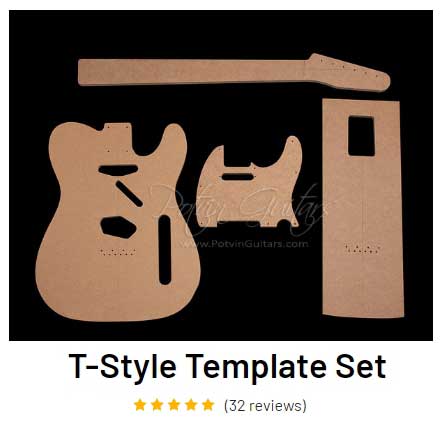Guitar Tonewood. Sigh.

“Guitar Tonewood” is a phrase I don’t really enjoy. There really is no such thing as tonewood. It’s a term that refers to wood that works well in the construction of guitars, but some people use it like it’s a magical type of wood. Wood is wood, it doesn’t contain “tone”. Let’s bust some myths by answering questions on the subject of electric guitar tonewood.
Yes, but everything about the guitar matters to the final sound you hear. Different woods have different properties that contribute to the overall sound of a guitar. Some contributions are so tiny, it’s arguable whether or not the human ear can actually detect them.
There is no “best” wood for guitars. Certain wood combinations produce a guitar that sounds appealing to most players, which explains why those woods are so popular.
It’s hard to declare a “winner” because every builder and major manufacturer uses different wood combinations. Some popular combinations are; ash or alder body with a maple neck; mahogany body with maple cap, mahogany neck, and rosewood fretboard.
Yes. However, some types of wood produce better results than others. For example, hard maple makes a great guitar neck, but a big slab of solid maple makes for a very heavy guitar, not to mention how it impacts the sound.
Here’s my advice- it’s your guitar, build it with any wood you like. Be prepared to make a few duds while learning which wood combinations you like. Also, be prepared to be told that your unusual wood choice is “not wood used for guitars”.
In some cases yes, but not always. That’s admittedly a wishy-washy answer, but one person’s “better” is different from the next. It’s generally accepted that acoustic guitars sound better with age. If you want to start a good internet fistfight, ask someone if the same is true for electric guitars.
What is true is that as wood ages, the moisture content continues to decrease, cell walls harden, and resins crystalize. These changes make the wood lighter, harder, and therefore more resonant. This aging process can be sped up through Torification.
That’s a little bit like asking “which sandwich has the most yummy”.
The real answer takes a little explanation. Sustain is a string’s ability to continue vibrating. Anything that deadens that vibration will reduce sustain. So what encourages a string to keep vibrating?
A stiff neck will keep strings vibrating longer, which is why you see a lot of maple necks and don’t see many made out of softwoods like pine.
Attach a maple neck to a styrofoam body you still won’t have much sustain, which means a rigid, dense body is also important. A solid oak body will sustain for days, but the weight and incredibly bright tone are less than ideal. Somewhere between styrofoam and solid oak is something like mahogany, a great choice that has good sustain combined with a nice weight.
Keep reading:

Mike Potvin
Chief Sawdust Officer
Don’t Take Chances
Learn the secrets to choosing great templates
Yes! Alert me when new Guitar Templates & Jigs are released



Thanks for doing what you do I’m new at luthiery but I was a carpenter for 20 years it’s become something I’m really into. There’s not many people out there that do it or whatever so thanks for putting this kind of stuff up man
Thanks Chad. I think you’ll find that a lot of your carpentry skills will be helpful in the guitar-building world.
You are an inspiration and a kind soul to take time too teach with great knowledge.
Thank you
Thank you 🙂
I made my first guitar, A Les Paul, with some rough sawn mahogany from a local lumberyard. In the end, it was super dense and really heavy (about 12 lbs). I find that it has little low end (bass) compared to my son’s PRS or Gibson Les Paul. Do you think a really dense piece of mahogany is contributing to this lack of low end? I am making some more LP’s (using your templates) and bought slabs of Mahogany from Exotic Woods in Burlington that have been pre-selected to be lighter and optimal for an electric guitar build. I am hoping they will sound better than my first build.
Don- everything in/on a guitar contributes to the “soup”. I try to a avoid absolutes like “this type of wood always creates this result”. I enjoy trying different types of wood, then when I think I like one, I make a bunch more guitars from the same kind of wood to see what results I get. Sometime you spot a pattern, or you learn that a certain type of wood, of a certain weight is what works best for a particular design. It’s probably not the answer you were hoping for, but guitar building is equal parts science and voodoo!